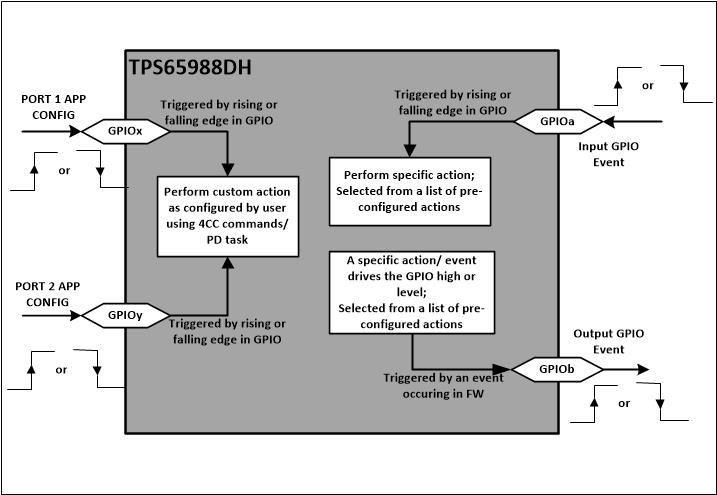SLVAF46A May 2021 – January 2023 TPS65988
2.3 GPIO Events
GPIO events feature enables users to map a PD or USB Type-C event inside the PD controller to a GPIO (see Figure 2-5).
- An output GPIO event asserts/de-asserts a GPIO pin based on the user selected polarity, when the mapped PD/ Type-C event occurs. For example, Plug Event can be used to reflect Type-C plug/unplug on a GPIO.
- Similarly, an Input GPIO event (rising or falling edge on a TPS665988DH GPIO pin, from an external signal in the system) can be used to trigger a specific PD or USB Type-C event inside the PD controller. For example, the Fault Input Event allows external devices to trigger error recovery on a given port.[2].
Using the Configuration Tool, a predefined event picked from the drop-down menu can be mapped to any of the GPIOs. A list of all the GPIO events can be found in the TPS65987DDH and TPS65988DH Host Interface Technical Reference Manual of the PD controller.
 Figure 2-5 GPIO Event
Figure 2-5 GPIO Event- Unlike input GPIO event that triggers a predefined PD or USB Type-C® event, an Application Configuration GPIO event provides more flexibility in the design to trigger custom actions using an input GPIO (see Figure 2-5). Custom actions could be configured by the user using 4CC commands or PD tasks in Configuration Tool, which otherwise needs an EC for issuing the same. In addition, an input GPIO mapped to an Application configuration event can be used to load a modified configuration to the PD controller at run-time.
Note:
- For details on 4CC commands/PD tasks, see the TPS65987DDH and TPS65988DH Host Interface Technical Reference Manual.
- Error recovery is a Type-C state to recover from any fault state. During error recovery state, a Type-C port removes CC termination for a defined amount of time and puts it back. This is to simulate a detach event and to make a new connection.